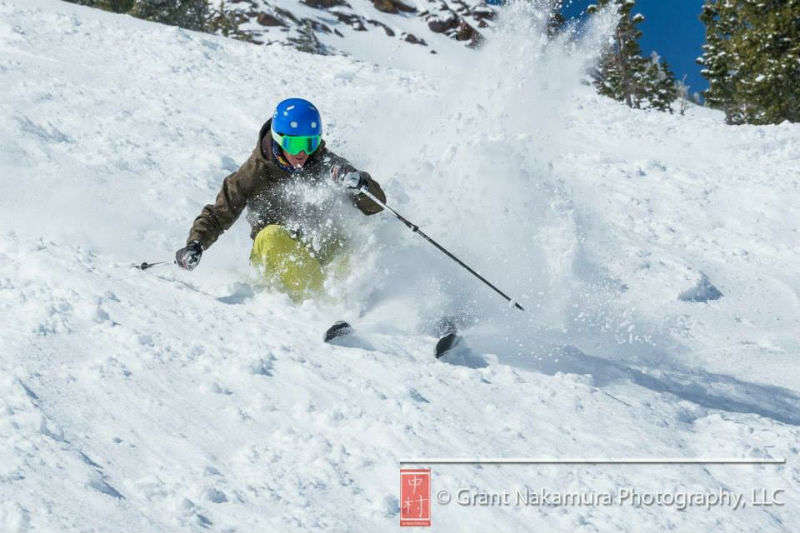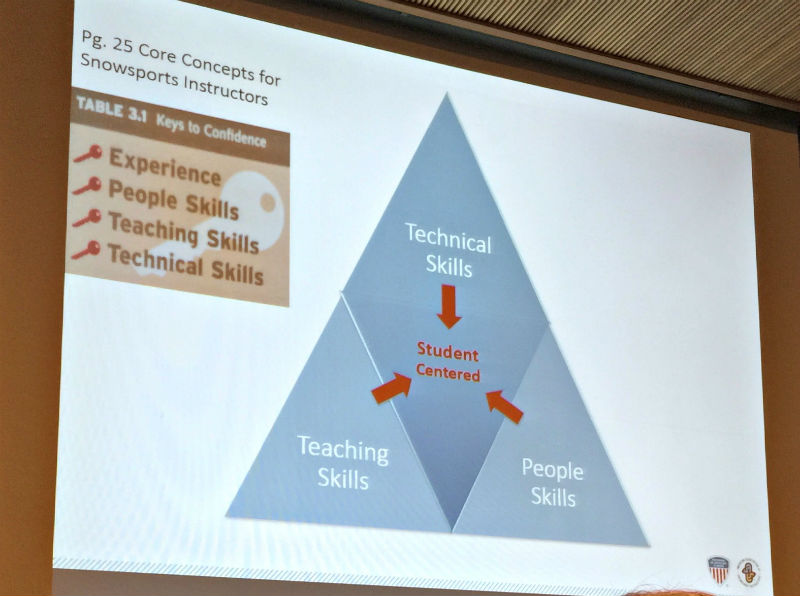Rudi and Dottie Schnackenberg Scholarship Recipient: Highlights from National Academy
Rudi and Dottie Schnackenberg Scholarship Recipient:
Highlights from National Academy
Kevin Jordan
5-10-2015
Thank you to PSIA-Rocky Mountain and the scholarship committee for granting me the Rudi and Dottie Schnackenberg Scholarship which allowed me to attend the National Academy in Snowbird, UT this past April 22-27. If you have not been to a National Academy, I would encourage you to attend one. It is a ski and snowboard instructors’ conference…on steroids! Snowbird is a challenging mountain and in late spring, the snow conditions can challenge even the best skier’s and rider’s abilities. We had a variety of snow conditions including no snow, ice, slush, mashed potatoes, deep manky snow, powder, and everything in between. Here are some highlights from the 2015 National Academy.
Sasha Rearick, the U.S. Ski Team’s Men’s Head Coach, gave an indoor presentation after skiing on day one. Sasha made some great points about skiing and ski racing including, “skiing is simple; we are the ones who make it complicated.” Rearick also demonstrated with the help of PSIA National Alpine Team Captain, Michael Rogan, the importance of pressure in the fall line. Together they set up a table and created a slope. Then Sasha rolled a ball that represented a skier’s center of mass. Rogan held a drink tray vertically to exemplify skis in the fall line and Sasha made the point that as the ball hit the tray at a diagonal, the center of mass maintained its speed. Next, Rogan held the drink tray at a 45 degree angle after the fall line. This represents what many of us, instructors and recreational skiers do. The pressure occurs after the fall line. Sasha rolled the ball and it slowed down. Thus, the center of mass did not maintain its speed. The demonstration resonated for everyone in the audience and became a topic of conversation for the week of the Academy.
Another indoor topic was related to the 2015 Interski Congress happening in Ushuaia, Argentina. Alpine Coach, Rob Sogard gave the presentation and unveiled what each of the different disciplines of the National Teams are currently working on for their Interski presentations. He showed three distinct triangles: one for technical skills, one for people skills, and one for teaching skills. These three triangles were encompassed in one larger triangle and together make up a guest centered experience. For example, the snowboard team members are working on people skills while the Nordic team is focused on a new model that comprises its technical skills. The Alpine team is focusing on teaching skills and people skills with an updated Core Concepts manual in the works. Sogard pointed out that the Alpine team members have worked hard on the National Standards, the five skiing fundamentals, and the new Alpine Technical Manual. Thus, Interski will be an opportunity for them to focus on teaching and people skills. Interski is being held in a very remote place and while at the Academy, participants helped raise over $6000 to help send team members. There is still more money to be raised to send each and every one of the team members to the end of the earth! Click here for more information: http://www.thesnowpros.org/Interski2015.aspx
Dean Cardinale was also a guest speaker on another evening. He works with the Snowbird Snow Safety office and is an avalanche forecaster, as well as an experienced mountaineer. His presentation gave an introduction into the history of Snowbird and the snow science behind avalanches. He had many stories about avalanches and explained how ski patrol trains and operates in the event of an emergency. The timing of his presentation was quite relevant since Snowbird saw over 14 inches of new snow and could not open some of its terrain due to poor visibility. Dean was able to explain how avalanche dogs are used to assist in the search and rescue of skiers, snowboarders, snowmobilers, and other recreational enthusiasts. Cardinale is incredibly knowledgeable and it was helpful to have a local expert explain snow science and snow safety to the Academy participants, many of whom come from smaller areas with not much avalanche risk or exposure.
The on-snow portion of Academy was excellent as well. How Academy works, is that you ski with the same group leader each morning and then have a chance to sign up for electives in the afternoon. One day is an elective day and it snowed, so we formed a group to rip around the terrain that Snowbird had to offer. It became a powder posse very quickly with Vail’s Bobby Murphy trying his best to rein us in. But we all know, “there are no friends on a powder day.” Especially, when we haven’t seen much powder this season! The National Team members work with you on your skiing by doing drills and giving you tips. In the afternoon, you have an opportunity to ski with other team members and continue to hone your skiing focus.
If you have never been to a National Academy, it is calling your name. Take advantage of the Rudi and Dottie Schnackenberg Scholarship. Your skiing will improve and you will have an opportunity to take advantage of the mountain playground that is Snowbird, UT. Plus, you will learn about the cutting edge information about instruction, such as Interski and PSIA-AASI’s partnership with USSA. There is also some fun to be had. Leki ski poles sponsored an après ski party on the Tram Plaza on the last day of Academy. Participants celebrated in the warm Utah sun while drinking beer. Need I say more? It is an event that is not to be missed and you will get more out of it than what you put into attending. I cannot thank PSIA-RM and the scholarship committee enough for helping me attend the National Academy.




